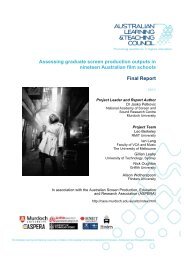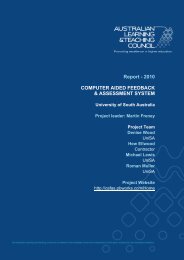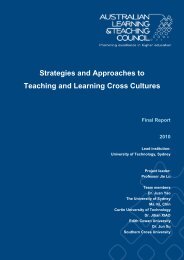student feedback and leadership - Office for Learning and Teaching
student feedback and leadership - Office for Learning and Teaching
student feedback and leadership - Office for Learning and Teaching
Create successful ePaper yourself
Turn your PDF publications into a flip-book with our unique Google optimized e-Paper software.
Student Feedback & LeadershipThe outcomes of the project are multi-facetted:First, a P.A.C.E.D. Distributed Leadership Model in the use of <strong>student</strong><strong>feedback</strong> to enhance <strong>student</strong> learning <strong>and</strong> teaching practice (hence<strong>for</strong>thtermed the P.A.C.E.D Distributed Leadership Model) was developed. ThisP.A.C.E.D Distributed Leadership Model has 5 <strong>leadership</strong> elements identifiedduring the project as being essential to enhance <strong>student</strong> learning experience:Participative Leadership – in which all stakeholders participate in two-waycommunication <strong>and</strong> consultation.Accredited Leadership – that recognises the need to recognise <strong>and</strong>reward staff <strong>for</strong> their contributions to enhanced learning <strong>and</strong> teachingpractice <strong>and</strong> to provide ongoing professional development support<strong>for</strong> <strong>leadership</strong>.Collaborative Leadership – in which top down policy is implementedfrom the bottom-up with middle-out support.Engaged Leadership – through which opportunities to network <strong>and</strong> sharelessons learnt within an agreed pedagogical framework are available.Devolved Leadership– by which action by all levels <strong>and</strong> functionsof Leaders across the university is congruent with University policy.The P.A.C.E.D. Distributed Leadership Model provides a framework that isadaptable both across the higher education sector, <strong>and</strong> to a variety of issuesbeyond that of the project issue focus of <strong>student</strong> <strong>feedback</strong>.Implementation of the P.A.C.E.D. Distributed Leadership Model assumesa process of change across the university. This led to the second outcomefrom this project – a Change Management Model that, while recognisingthe central role of the individual academic in enhancing <strong>student</strong> learning <strong>and</strong>teaching practice, acknowledges the need <strong>for</strong> a holistic multi-level <strong>leadership</strong>approach across the university. The R.E.A.L.I.S.E.D. Change ManagementModel has 8 elements that relate to the 5 elements of the P.A.C.E.D.Distributed Leadership Model:Recognition – of individual academic excellence in enhancing <strong>student</strong>learning <strong>and</strong> teaching practice through <strong>Teaching</strong> Excellence Awards<strong>and</strong> Promotion opportunities.Encouragement – of the individual academic through the provision oftime <strong>and</strong> financial support to design <strong>and</strong> develop learning <strong>and</strong> teachingpractice innovations.Acknowledgment – of the link between university strategic plans <strong>and</strong>individual academic learning <strong>and</strong> teaching practice.Leadership –from each of the multi-levels across the university thatis congruent <strong>and</strong> supportive of a participative <strong>and</strong> collaborative approach.Page 2
















